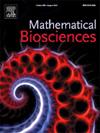对干细胞增殖潜能动态和卵巢功能障碍病例中不同疗法的研究,采用了一种模拟方法。
IF 1.9
4区 数学
Q2 BIOLOGY
引用次数: 0
摘要
本文提出了一个基于常微分方程的离散数学模型和由偏微分方程形成的相关连续模型,模拟干细胞群体的世代和时间演变。模型参数为最大增殖潜能以及有丝分裂率、死亡事件和端粒酶活性。建议将每个时间点的平均增殖潜能作为群体老化的指标。该模型适用于健康人最大增殖潜能变化范围内具有不同端粒酶活性率的造血干细胞(HSCs),以研究老化的时间演变。造血干细胞能表达端粒酶,但其水平不足以在衰老过程中维持端粒长度不变[1](齐默尔曼和马腾斯,2008年;弗洛雷斯等人,2008年)。众所周知,患有原发性卵巢功能不全(POI)的女性颗粒细胞和外周血单核细胞中端粒酶活性较低(Xu 等人,2017 年)。将此推断到造血干细胞,该数学模型显示了当端粒酶表达被性类固醇激活、被内源性启动子激活或被腺相关病毒中的外源性强启动子基因治疗激活时,细胞群增殖潜力的差异。在第一种情况下,POI 状态下细胞的增殖潜力会增加,但当使用腺相关病毒时,增殖潜力会达到健康细胞群的水平。本文章由计算机程序翻译,如有差异,请以英文原文为准。
An in-silico approach to the dynamics of proliferation potential in stem cells and the study of different therapies in cases of ovarian dysfunction
A discrete mathematical model based on ordinary differential equations and the associated continuous model formed by a partial differential equation, which simulate the generational and temporal evolution of a stem cell population, are proposed. The model parameters are the maximum proliferation potential and the rates of mitosis, death events and telomerase activity. The mean proliferation potential at each point in time is suggested as an indicator of population aging. The model is applied on hematopoietic stem cells (HSCs), with different telomerase activity rates, in a range of variation of maximum proliferation potential in healthy individuals, to study the temporal evolution of aging. HSCs express telomerase, however not at levels that are sufficient for maintaining constant telomere length with aging [1], [2]. Women with primary ovarian insufficiency (POI) are known to have low telomerase activity in granulosa cells and peripheral blood mononuclear cells [3]. Extrapolating this to hematopoietic stem cells, the mathematical model shows the differences in proliferation potential of the cell populations when telomerase expression is activated using sexual steroids, though the endogenous promoter or with gene therapy using exogenous, stronger promoters within the adeno-associated virus. In the first case, proliferation potential of cells from POI condition increases, but when adeno-associated viruses are used, the proliferation potential reaches the levels of healthy cell populations.
求助全文
通过发布文献求助,成功后即可免费获取论文全文。
去求助
来源期刊

Mathematical Biosciences
生物-生物学
CiteScore
7.50
自引率
2.30%
发文量
67
审稿时长
18 days
期刊介绍:
Mathematical Biosciences publishes work providing new concepts or new understanding of biological systems using mathematical models, or methodological articles likely to find application to multiple biological systems. Papers are expected to present a major research finding of broad significance for the biological sciences, or mathematical biology. Mathematical Biosciences welcomes original research articles, letters, reviews and perspectives.
 求助内容:
求助内容: 应助结果提醒方式:
应助结果提醒方式:


